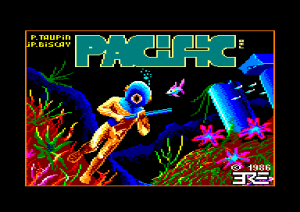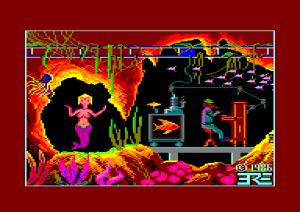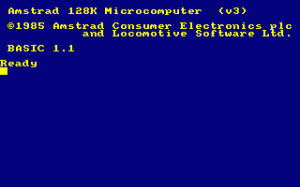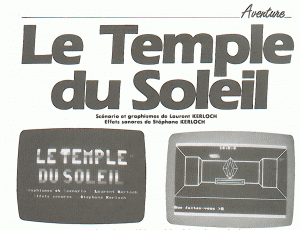The early days (2/10) - the Amstrad phase
Soon enough I am back to my father’s place, enjoying a new school holiday period. I am in Fifth Grade. I come back with undisguised pleasure to the Apple and the adult world.
And there, I am shocked! Another machine sits next to the well-known Apple IIe keyboard. Black, green, red: I am in front of a brand new Amstrad CPC 464. And games. Pacific, Crafton & Xunk. Feverish, I watch my dad introduce the Pacific tape in the cassette deck. Cassette? Bitter disappointment for a long-time floppy disks user: the CPC only reads tapes! The loading time is unbearable! But something new makes me quickly forget this detail: colors. There are colors on the screen! It is a completely different world compared to the sad monochrome Apple II screen. More lively, more playful, less austere. Maybe a bit less adult as well… A moment later I am shocked again: the Amstrad plays music! I am flabbergasted. The limited beeps from the Apple suddenly seem very sad and very distant. Music! I can not believe it.
Follows a period of euphoria during which I suffer the brunt of the two best ERE Informatique games at the time. Pacific. And Crafton. I am mesmerized by Pacific. The silent world and its 32000 screens, according to the manual. 32000?! THIRTY-TWO THOUSAND!!! It seems like an astronomical number! How? How is this possible? Remembering the size of the Spells source code, which scrolled for pages and pages, eventually producing what was only a limited text adventure game, I remain perplexed. The listing from Pacific must be monstrous. 32000 screens! In a word, I am puzzled. And my love for impressive programming feats might very well come from that moment. Was it really a feat of engineering? Probably not – I assume the world was ‘just’ procedurally generated - but for me it did the trick. The number broke the limits of my imagination, “pushed the envelope” to quote Dave Small (of SPECTRE GCR fame), and that’s what mattered. After Pacific, my vision of gaming would never be the same.
Days. I spent days underwater, scouting the ocean in search of lost treasures. Days, not nights. I was still a kid. Around 10 PM, I had to go to bed no matter what. It felt terrible. My only desire was to wake up quickly the next day to continue exploring the ocean. And I was not alone! My father also got the virus. He said he had bought the Amstrad for us, but what a joke! He played as much as I did! Ok, fair enough, maybe not that much. Still, he completed Pacific before me. I have this unreal memory: I woke up one morning with a vague recollection of something happening during the night. Images of a fuzzy shape on a screen. I knew that something had happened but could not remember what it was. The answer came to me a few moments later when my dad entered my room, all smiles: “Do you remember the mermaid?”… It exploded in my head. The mermaid! That was the shape I remembered! I dreamt about a mermaid. But wait, what? How does he know what I was dreaming of? Simple: my dad had completed Pacific during the night, and the end-screen was a mermaid. Since you cannot save in that game, he had taken upon himself to wake me up in the middle of the night, to show it to me. And of course since I was half asleep I did not remember any of it. Just that I dreamt about a mermaid that night…
Anyway.
I was clearly hooked. I had the virus.
That fever did not go down afterwards, quite the contrary. I usually do not do things by halves. I am rather passionate. I do things thoroughly. Thus overnight I let the Apple go and seriously considered convincing my mother to get a CPC for our other place, near Paris. The details are unimportant: it took time but it eventually happened. I spent all my pocket money on games. Of course they were incredibly expensive for a small kid. I started reading all the Amstrad-related magazines I could… and there were a lot of them. Amstrad Magazine, Amstar, Arcades, CPC, Amstradhebdo, Hebdogiciel… Oh boy, Hebdogiciel! Obviously fascinating for a kid who wants to be an adult. Iconoclastic, provocative, hilarious, educational, erotic. The cheeky Hebdogiciel was the perfect magazine which, much better than any teacher, taught me about the most precious thing in the world: freedom. And independence. This was a unique journal, completely politically incorrect, with reviewers calling a cat a cat, not hesitating a second before destroying a bad game or spitting on compagnies that tried to rip off their customers – which gave birth to a few hilarious reviews. Freedom of speech at its best. I have never seen anything quite like it afterwards.
As far as programming was concerned, the listings contained in Hebdogiciel were absolute gems. There was just no better way to learn. After the Amstrad boots, you are left with a small yellow blinking cursor on a blue background, along with a laconic message: ‘Ready.’ And then you’re on your own! To run any application, any game, you must enter at least one BASIC command. And if you fancy going further, it is childish: the BASIC language is built-in, in the ROM, waiting for you. You just need to type. That is what Hebdogiciel’s weekly listings were here for. Obviously formative, obviously tempting, obviously instructive: what Amstrad owner has not copied a listing off a magazine in his life? I learnt BASIC naturally, without really realizing, to have fun playing Rescue Mission and Le Temple du Soleil.
The Temple of the Sun: another highlight in my journey playing games on Mr Sugar’s machines. It was in a special issue of the CPC journal. The kind of issue you can not even imagine those days. For people who discovered games later, with Doom, Quake or Warcraft, that stuff would make you look like a complete freaky retarded mutant, not a gamer. Think about that: a special issue of a magazine containing… source code! Pages and pages of printed BASIC code, from the first page to the last. That’s it. With maybe a small screenshot in a corner to brighten up the whole thing, even though you can easily imagine the pictures produced by amateur BASIC code had a hard time brightening up anything. A full magazine! I now understand my mother’s horrified reactions upon discovering my ‘readings’. I must have been in Sixth or Seventh Grade! Anyway, the Temple of the Sun – le Temple du Soleil. Now that was a listing. It must have been the longest listing in the whole magazine, pages and pages of source code. But the result looked incredible for an amateur game published in a journal. So I took my courage in both hands, and I typed. I was on holiday at my father’s place, and alone in the intimidating Red Chamber, I typed this never-ending listing. It took me several days to type it, and also to correct any typos. But I finally ran the program, and I entered the Temple Du Soleil.
First surprise: there was some music! Wow, I typed instructions generating sound without even realizing it. And it did not even sound bad! I never understood how to use the sound-related commands from the Amstrad’s BASIC, what were the envelope, timbre, frequency and all that stuff. I was too young. And thus, being rewarded with such a pretty melody, while having no clue how it worked, created an indescribable sense of magic that only strengthened the general room ambience. I was an alchemist-wizard locked in his laboratory, engaged in his experiments, and I had just discovered the philosopher’s stone.
Second surprise: the game was excellent. A by-the-book exploration of the Pyramid of the Sun, with its treasures, its jewels, its deadly traps, its beetles and other mummies. Charmed, fascinated, I explored “my” own game for days. I pushed as far as to rummage through old dictionaries and encyclopedias to find out about what had been the starting point of the game in the spirit of the author: the Pyramid of the Sun. I was not interested simply in the software born from my hands, but I also looked up everything that reminded me of it. This is how I learnt about the Step Pyramid of Teotihuacan in Mexico, the Quetzalcoatl, the worship of the sun and so on.
Suddenly I was far away from computers and video games! I was immersed in the Inca and Mayan customs. Smoothly, as if it had been the most natural thing in the world, I had gotten myself interested in things that would have made me yawn with boredom if anybody had tried to teach them to me at school. Learning by playing, that’s the secret. Dave Small wrote it before me. And thanks to these computers, these video games supposed to make kids violent and transform them into morons (I’ll spare you the usual bullshit), I had managed to consecutively learn BASIC and some of Mexico’s history. Moreover, this is the kind of things you do not forget. I was 10. I still remember it. This may not be possible anymore those days. Of course kids still play games, much more so than before. But they are flooded with them, and games are very easy to get: download, play, forget. You do not have to fight for them. There is no emotional bond, no emotional attachment between you and a program you spent days typing, one character at a time. Who would publish a listing in a magazine today? Worse: when something boots up, it is a PC. And you do not end up in front of BASIC anymore, you end up in front of Windows. All you need to do is click your way out of trouble. Programming languages became a lot more difficult to learn and start playing with. What happened to BASIC?
My Amstrad phase lasted a few years, during which I tried everything I could: games, tools, programming, computer graphics. I started dozens of game projects in BASIC, only finishing up a few of them. BASIC’s limited power frustrated me. In CPC I tried to dissect the assembly code from RSX extensions that the magazine frequently published. In vain. I knew about 3 of the Z80 opcodes and I had some trouble to understand the concepts of registers, stack, etc. I gave up and wallowed in video games. Until one day…



